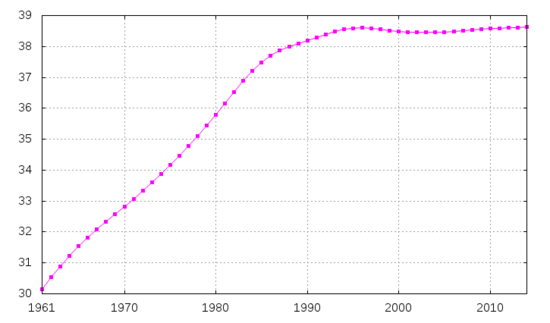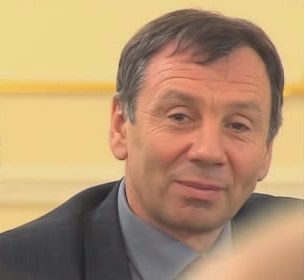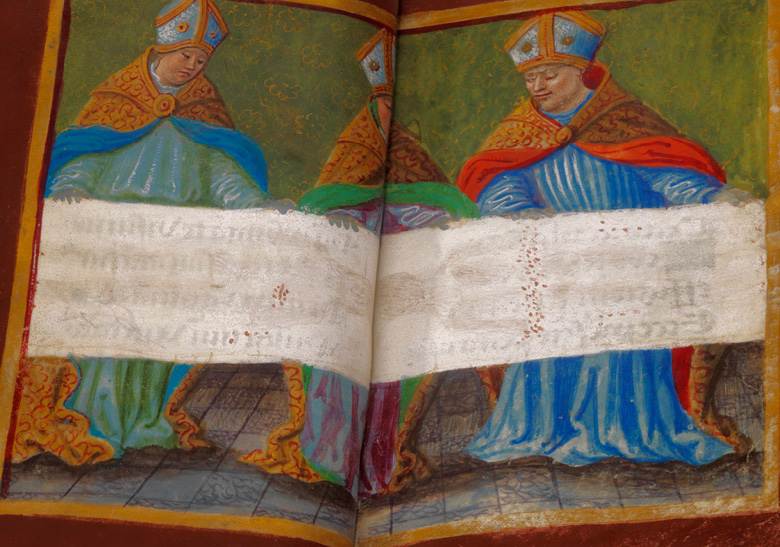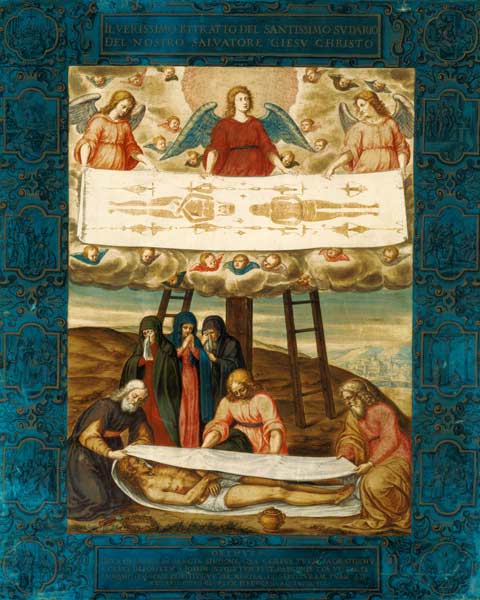[Index: #1, #2, #3, #4, #5, #6, #7, #8, #10 & #11]
Introduction. This is part #9 of my concluding summary of the evidence that the 1988 radiocarbon dating of the Shroud of Turin as "mediaeval ... AD 1260-1390"[2] was the result of a computer hacking, allegedly by Arizona radiocarbon dating laboratory physicist Timothy W. Linick (1946-89)[3], aided by German hacker Karl Koch (1965–89)[4], on behalf of the former Soviet Union, through its agency the KGB. Previous posts in this series were parts: #1, #2, #3, #4, #5, #6, #7 and #8. I will link the main headings in these posts back to my previous, "My theory ..." posts on those topics. The next post in this series is part #10.
[Above: "Sergei [or Sergey] Markov in February 2012"[5]. The Soviet official who the German hackers (including Koch) sold their hacked secrets to was a "Sergei Markov":
"For both Dob [Dirk-Otto Brezinski] and Carl [Peter Carl] it became apparent after an hour or so of being questioned that Pengo [Hans Heinrich Hübner] and Hagbard [Karl Koch] had gone to the authorities. Eventually, both of them confessed to espionage. But they weren't to be accorded the same leniency that Markus Hess got. ... Both were taken into custody. ... prosecutor Kohlhaas ... saw his case strengthen when, during the search of Carl's apartment, a Casio pocket calculator was found. It contained the telephone number for one Sergei Markov"[6].
The Sergey Markov in the photo above has been described as "Putin's man"[7]. In 2009 this "Sergei Markov" admitted to being behind a hacking cyber-attack on Estonia [8, 9]. While I can as yet find no evidence that this Sergey (or Sergei) Markov was a former KGB agent (he need not have been), I assume that he is the "Sergei Markov" who was the Soviet Union's point of contact with the German "KGB hackers" which included Karl Koch[10].
■ The Soviet Union had a motive to discredit the Shroud [#10(10) & #9]
• The Soviet Union was an atheist state. State atheism was an official policy in the Soviet Union[11]. The "USSR had, as an ideological objective, the elimination of religion and its replacement with atheism ... `Science' was counterposed to `religious superstition' in the media and in academic writing":
"At the time of the 1917 Revolution, the Russian Orthodox Church was deeply integrated into the autocratic state, enjoying official status. This was a significant factor that contributed to the Bolshevik attitude to religion and the steps they took to control it. Thus the USSR became the first state to have, as an ideological objective, the elimination of religion and its replacement with universal atheism. The communist regime confiscated religious property, ridiculed religion, harassed believers, and propagated atheism in schools. ... the communists aimed to break the power of all religious institutions and eventually replace religious belief with atheism. `Science' was counterposed to `religious superstition' in the media and in academic writing ..."[12]"Anti-religious and atheistic propaganda was implemented into every portion of soviet life ... publication of religious writing was banned":
"After the Russian Civil War, anti religious movements in the Soviet Union (gosateizm) attempted to stop the spread of religious beliefs as well as remove `prerevolutionary remnants'. The Bolsheviks were particularly hostile to the Russian Orthodox Church ... organizations as the League of the Militant Godless ridiculed all religions and harassed believers. Anti-religious and atheistic propaganda was implemented into every portion of soviet life: in schools, communist organizations ... and the media ... efforts to reorganise the week to improve worker productivity saw the introduction of the Soviet calendar, which had the side-effect that a `holiday will seldom fall on Sunday'. Within about a year of the revolution, the state expropriated all church property, including the churches themselves, and in the period from 1922 to 1926, 28 Russian Orthodox bishops and more than 1,200 priests were killed (a much greater number was subjected to persecution). Most seminaries were closed, and publication of religious writing was banned. The Russian Orthodox Church, which had 54,000 parishes before World War I, was reduced to 500 by 1940."[13]The Shroud was included in this suppression of religion in the Soviet Union. Russian physicist Dr. Alexander Belyakov of the Moscow Center of Shroud Study, prefaced his address at a 1996 Shroud conference in Italy with, "In spite of the great interest in the Shroud among Christians and other people in Russia, there were no explorations of the Shroud up to now in our country ... [due to] the prevailing atheistic ideology":
"I am very grateful to the organizers of the conference for the invitation. It is a pleasure and a great honor for me to speak before you here, in Italy, where the great Christian relic - the Shroud of Jesus Christ - is stored ... In spite of the great interest in the Shroud among Christians and other people in Russia, there were no explorations of the Shroud up to now in our country. The reason is the presence of the prevailing atheistic ideology. Now the situation has changed ... `...in Russia and Russian Orthodox Church there is a great interest to the Shroud of Turin'"[14]
• The Soviet Union was on the verge of collapse in the 1980s. By the mid-1980's the former Soviet Union (USSR) was on the verge of collapse:
"The prevailing mood of the Soviet leadership at the time of Brezhnev's death in 1982 was one of aversion to change. The long period of Brezhnev's rule had come to be dubbed one of "standstill", with an aging and ossified top political leadership. ... In 1988, the Soviet Union abandoned its nine-year war in Afghanistan and began to withdraw its forces. ... In the late 1980s, the constituent republics of the Soviet Union started legal moves towards potentially declaring sovereignty over their territories, citing Article 72 of the USSR constitution, which stated that any constituent republic was free to secede."[15].And in fact the USSR did collapse in late 1989, epitomised by the fall of the Berlin Wall on 9 November 1989[16].
[Above: Germans on and around the Berlin Wall at the Brandenburg Gate, 10 November 1989[17].]
• A first century radiocarbon date of the Shroud would have been a threat to the atheist USSR. Yet, despite its attempts to eradicate religion since the 1917 revolution, the USSR continued to have a large Christian population[18]. In the 1980s, three Christian denominations alone, had a total of about 56.5 million adherents:"According to both Soviet and Western sources, in the late 1980s the Russian Orthodox Church had over 50 million believers ... The Georgian Orthodox Church ... In the late 1980s ... had ... an estimated 2.5 million followers ... The Armenian Apostolic Church ... In the 1980s ... had about 4 million adherents ..." [19]
And that does not count the 5.5 million Roman Catholics mainly in the satellite republics:
"Catholics formed a substantial and active religious constituency in the Soviet Union ... The majority of the 5.5 million Roman Catholics in the Soviet Union lived in the Lithuanian, Belarusian, and Latvian republics, with a sprinkling in the Moldavian, Ukrainian, and Russian republics."[20].
Nor does that count the Roman Catholics in Poland in the 1980s, which, assuming they were 80% of the population:
"There are 44 Catholic Dioceses in Poland ... Ever since Poland officially adopted Latin Christianity in 966, the Catholic Church has played an important religious, cultural and political role in the country ... As of 2005 a majority of Poles, approximately 88%, identified themselves as Roman Catholic, and 58% said they are active practicing Catholics, according to a survey by the Centre for Public Opinion Research. ... The CIA Factbook gives a number of 87.2% belonging to the Roman Catholic Church in 2012"[21].
and given a 37.5 million population in Poland in 1987 (see graph),
[Right (enlarge): Graph showing the population in Poland was about 37.5 million in 1987[22].]
that means there were about 30 million Roman Catholics in Poland in the late 1980s.
That totals about 92 million Christians in the Soviet Union in the 1980s. And if Protestants and other Christian denominations are included, that means there could have been about 100 million Christians in the crumbling, officially atheist, Soviet Union in the 1980s!
So a first-century radiocarbon date of the Shroud of Turin would have been perceived as a huge threat by the embattled Soviet leadership.
• If Timothy W. Linick had offered the Soviets a 14th century radiocarbon date of the Shroud they would have accepted it. So if Arizona radiocarbon dating laboratory physicist, Timothy W. Linick (see part #6) had approached the Soviet Union (through for
[Right: Photograph of Linick and report that, "He died at the age of forty-two on 4 June 1989, in very unclear circumstances ..."[23]. This is consistent with my theory that the KGB executed confessed KGB hacker Karl Koch between 23 and 30 May 1989 (see part #8), and Linick on 4 June 1989[24], the day after the West German police had publicly released the identity of a burnt body as Koch's on 3 June 1989[25], to prevent Koch or Linick revealing that the radiocarbon dating of the Shroud to 1325 ±65[26] was the result of a KGB-sponsored computer hacking by Linick, aided by Koch.]
example the Soviet consulate in San Francisco):
"Since most of what they [the Soviet Union] were interested in, especially technology for advanced computing, was on a list of highly restricted technologies maintained by a consortium of Western nations known as COCOM, the Soviets had long since resorted to extralegal means of procuring hardware and software. The FBI liked to maintain that Northern California's Silicon Valley, where much of American computer innovation resided, was crawling with KGB agents. The FBI claimed that one of the primary missions of the Soviet consulate in San Francisco was to funnel U.S. technology into the Soviet Union"[27].with an offer to guarantee that the Shroud would be radiocarbon dated to about 25-30 years before it first appeared in undisputed history at Lirey, France, in the 1350s (see part #1), the Soviets would surely have accepted that offer.
Continued in part #10 of this series.
Notes
1. This post is copyright. Permission is granted to quote from any part of this post (but not the whole post), provided it includes a reference citing my name, its subject heading, its date, and a hyperlink back to this post. [return]
2. Damon, P.E., et al., 1989, "Radiocarbon Dating of the Shroud of Turin," Nature, Vol. 337, 16th February, pp.611-615, p.611. [return]
3. Jull, A.J.T. & Suess, H.E., 1989, "Timothy W. Linick," Radiocarbon, Vol 31, No 2. [return]
4. "Karl Koch (hacker)," Wikipedia, 1 April 2016. [return]
5. "Sergey Alexandrovich Markov," Wikipedia, 25 June 2016. [return]
6. Hafner, K. & Markoff, J., 1991, "Cyberpunk: Outlaws and Hackers on the Computer Frontier," Corgi: London, reprinted, 1993, pp.292-293. [return]
7. "Putin's Man Warns Finland About NATO Membership and Russophobia," Finbay, 9 June 2014. [return]
8. Coalson, R., 2009, "Russia admits to Cyber Attack on Estonia," La Russophobe, March 9. [return]
9. Leyden, J., 2009, "Russian politician: 'My assistant started Estonian cyberwar'," The Register, 10 March. [return]
10. Hafner & Markoff, 1991, p.293. [return]
11. "State atheism: Soviet Union," Wikipedia, 23 July 2016. [return]
12. "Religion in the Soviet Union," Wikipedia, 23 May 2016. [return]
13. "State atheism: Soviet Union," Wikipedia, 23 July 2016. [return]
14. Belyakov, A., 1996, "Prospects of Research of the Turin Shroud in Russia," Shroud.com. [return]
15. "Soviet Union," Wikipedia, 21 July 2016. [return]
16. "Berlin Wall," Wikipedia, 9 July 2016. [return]
17. Ibid. [return]
18. "State atheism: Soviet Union," Wikipedia, 23 July 2016. [return]
19. "Religion in the Soviet Union," Wikipedia, 23 May 2016. [return]
20. Ibid. [return]
21. "Roman Catholicism in Poland," Wikipedia, 4 June 2016. [return]
22. "Demographics of Poland," Wikipedia, 10 July 2016, [return]
23. Bonnet-Eymard, B., 2000, "The Holy Shroud is as Old as the Risen Jesus, IV. Caution! Danger!, The Catholic Counter-Reformation in the XXth Century, No 330, Online edition, May. [return]
24. Jull & Suess, 1989. [return]
25. "WikiFreaks, Pt. 4 `The Nerds Who Played With Fire'," The Psychedelic Dungeon, 15 September 2010h; and Clough. B. & Mungo, P., 1992, "Approaching Zero: Data Crime and the Computer," Faber & Faber: London & Boston, p.163. [return]
26. The cited radiocarbon dating range "1260-1390" of the Shroud is equivalent to "the year AD 1325, give or take sixty-five years either way." (Wilson, I., 1998, "The Blood and the Shroud: New Evidence that the World's Most Sacred Relic is Real," Simon & Schuster: New York NY, p.7). [return]
27. Hafner & Markoff, 1991, p.226. [return]
Posted 30 July 2016. Updated 27 February 2024.










